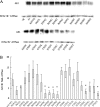Dual transport properties of anion exchanger 1: the same transmembrane segment is involved in anion exchange and in a cation leak
- PMID: 21257764
- PMCID: PMC3059035
- DOI: 10.1074/jbc.M110.166819
Dual transport properties of anion exchanger 1: the same transmembrane segment is involved in anion exchange and in a cation leak
Abstract
Previous results suggested that specific point mutations in human anion exchanger 1 (AE1) convert the electroneutral anion exchanger into a monovalent cation conductance. In the present study, the transport site for anion exchange and for the cation leak has been studied by cysteine scanning mutagenesis and sulfhydryl reagent chemistry. Moreover, the role of some highly conserved amino acids within members of the SLC4 family to which AE1 belongs has been assessed in AE1 transport properties. The results suggest that the same transport site within the AE1 spanning domain is involved in anion exchange or in cation transport. A functioning mechanism for this transport site is proposed according to transport properties of the different studied point mutations of AE1.
Figures








References
-
- Yool A. J., Weinstein A. M. (2002) News Physiol. Sci. 17, 68–72 - PubMed
-
- Ryan R. M., Vandenberg R. J. (2005) Clin. Exp. Pharmacol. Physiol. 32, 1–6 - PubMed
-
- DeFelice L. J., Goswami T. (2007) Annu. Rev. Physiol. 69, 87–112 - PubMed
-
- Vandenberg R. J., Huang S., Ryan R. M. (2008) Channels 2, 51–58 - PubMed
MeSH terms
Substances
LinkOut - more resources
Full Text Sources
Other Literature Sources
Miscellaneous

